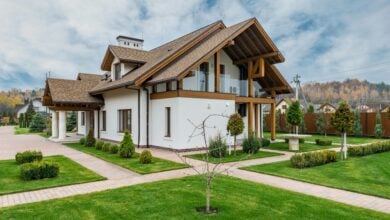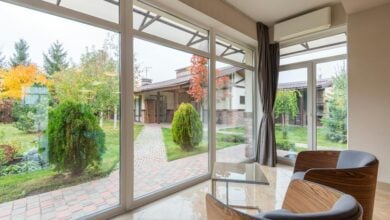Mezzanines are additional floors that are increasingly becoming popular in modern homes. Representing a shift from expansive spaces to compact ones, beautiful mezzanine structures enable homeowners to increase their indoor space without necessarily expanding. Also, this adds to the home’s selling value and aesthetics.
As flexible additions created above already existing rooms, mezzanines not only add beauty to the interior design of a home or building. In most instances, these open spaces such as steel mezzanine stairs are created to have vital functions to the room. In homes, these may serve as libraries, working areas, or bedrooms. The design of any mezzanine space typically depends on how it’ll be used.
Mezzanine Space Considerations
If you’re planning to improve your home by adding a mezzanine space, there are several things you need to consider. One of these is how you can design the space more efficiently to make it functional and useful.
Below are some tips to help you design an efficient mezzanine space:
1. Determine The Available Space You Have
When you decide to add a mezzanine space to your existing structure, your first step should be to establish how much space you have. Technically, the mezzanine space you add can only be as big or as small as the area you have. Determining the amount of space you have will enable you to measure the dimensions of your mezzanine.
If the space you have can fit a wide mezzanine, then go ahead and create one. When you know how much width, length, and height you have available, you’ll also be able to determine what you’ll use the structure for. If the space is small, you can use it to set up a working area or a library.
2. Craft A Clear Plan
Once you’ve known the measurements, you need to develop a plan for the mezzanine space before you can start building it. Since mezzanines are constructed on already existing spaces, it’s important to craft a detailed plan to ensure the space is designed the way you anticipated it to avoid regrets.
On the flip side, the cost of not planning your mezzanine space well is high. A poorly planned mezzanine can take up plenty of space, causing your home to appear smaller and crowded. It’s therefore important you critically evaluate your house to determine whether it can accommodate additional elements, so plan the space well.
3. Decide How To Use Mezzanine Space
Before you start creating a mezzanine space, you’ll need to determine what you want to use it for. Mezzanine spaces can be used to hold an additional sleeping area, a working area, a home library, or anything else you want. However, you have to ensure the space you have is suitable for the function you choose.
If the space you’re working with is smaller than you had anticipated, don’t insist on getting the mezzanine to serve the purpose you want. Instead, customize it for a different function that’s more ideal.
4. Build The Space With Sturdy Materials
When you’re designing a mezzanine space, the focus shouldn’t just be on its beauty, but it should also be on the strength of the materials you’ll be using. For the mezzanine space to be efficient, it should be sturdy and stable. 
Various materials can be used to build a mezzanine. They include mild steel, light metal, wood, and concrete. If you wish to create a feeling of openness, consider using transparent materials, metal grids, or wooden grills on your mezzanine space.
5. Keep Functional Spaces Above And Below
Whatever materials you choose, ensure your mezzanine space isn’t constructed too high. Ideally, the height of the mezzanine shouldn’t exceed three meters. Maintaining this height will not only keep your costs modest but it’ll also ensure the space is secure and sturdy. To enhance the efficiency of your space, ensure you leave appropriate allowance above and below.
The space above the mezzanine should be sufficient for you to stand upright and allow you enough area to move around. You also need to maintain a functional space below and you need to be sure people can walk without any hindrances. However, if the space below is too small, it can serve as storage.
6. Install Stairs For Better Accessibility
You can design your mezzanine space for efficiency by adding stairs to make it more accessible. As you install the stairs, ensure they’re safe by including handrails. Be creative with the design to make them more appealing and ensure they don’t take up too much space. If you’re struggling with your area, a great way to try is to use spiral stairs.
In addition to making your mezzanine highly accessible, consider installing proper lighting in the space. Opt for lights ideal for the function you’ll be using the space for. To enhance efficiency, make your mezzanine lighting controlled from the space below. This will enable you to turn the lights on and off without having to go up.
7. Ensure Good Heat And Air Circulation
Mezzanine spaces can become too hot compared to the space below due to rising heat. As such, it’s advisable to consider the heating and air circulation aspects of this additional space during the design phase. To reduce the heat, consider installing an insulator. Also, make the space open to support air circulation.
As you install, consider the budget you have and assess whether you’d do it on your own or with the help of a professional. Also, see to it that the project would be done without any interruptions to ascertain the quality. As always, seek advice before starting on your endeavor.
Conclusion
Adding a mezzanine to your interior is a great way of creating additional space. Mezzanine spaces can be used for different functions including a working area, additional bedroom, or a home library.
To design this efficiently, you need to consider the amount of space you have available and what you want to use it for. To develop an efficient design, pay attention to the tips discussed above and apply them in your preparations.




